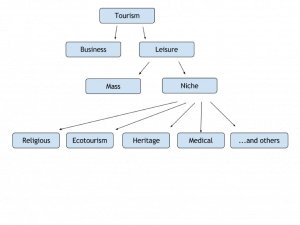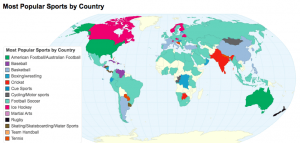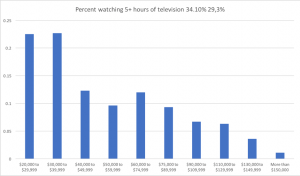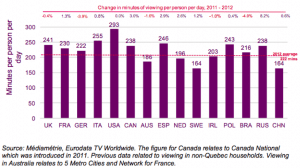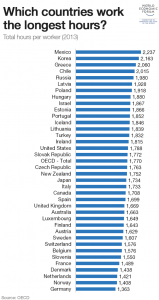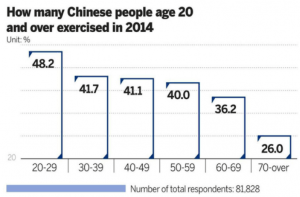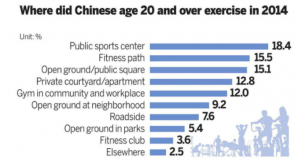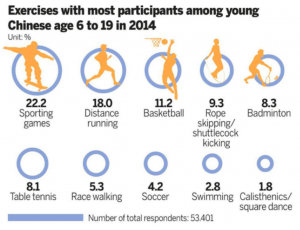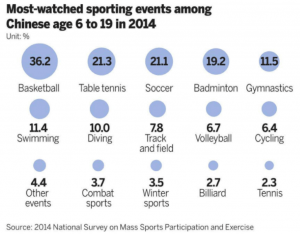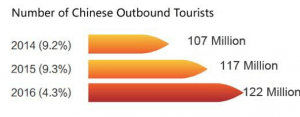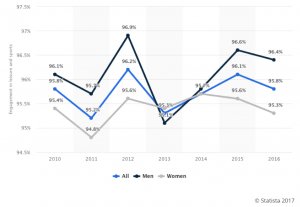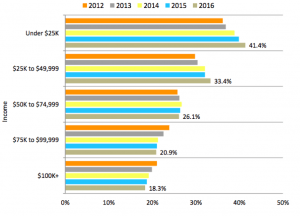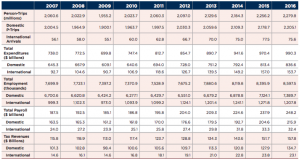Key Question: How have human development processes given rise to leisure activities?
[Weeks 2 & 3] By the end of Week 3, you should be able to:
- Examine the growth and changing purpose of leisure time for societies in different geographic and developmental contexts.
- Identify the categorization of touristic activities (cost, duration and destination) and sporting activities (cost, popularity, site).
- Outline the link between economic development and participation in leisure activities.
- Discuss factors affecting personal participation in sports and tourism, including affluence, gender, stage in lifecycle, personality and place of residence.
Part 1 – Introduction to Leisure, tourism and sport
Leisure is defined for the purposes of this optional theme as any freely chosen activity or experience that takes place in non‑work time. The leisure and tourism industry is a significant and rapidly expanding global economic sector.
A. Differentiating between LEISURE, TOURISM and SPORT
Compare leisure, sport and tourism activities and explain why they may be difficult to categorize.
- Think of different types of leisure, sport and tourist activities –
- Classify them into groups.
Leisure, tourism and sport can overlap. You could be doing a sporting activity while on vacation enjoying your leisure time. How are these terms distinct from one another?
- Define the THREE terms.
- Examine your definitions and then go back to your list – do some activities overlap? Now look at the definitions below and rethink your categorization.
According to the IBO…
LEISURE: “Any freely chosen activity or experience that takes place in non-work time.” (IBO, 2009: 32)
TOURISM: “Travel away from home for at least one night for the purpose of leisure.” (IBO, 2009: 33)
“The movement of people to countries or places outside their usual environment for personal or business/professional purposes. These people are called visitors…and tourism has to do with their activities.” (UNWTO, 2012)
SPORT: “A physical activity involving a set of rules or customs. The activity may be competitive.” (IBO, 2009: 33)
- Create a Venn diagram organizing and categorizing your list of activities.
B. Challenges with categorization of touristic activities
Aside from the overlap between these definitions, there is also difficulty with defining specific activities. Some people may argue an activity is a sport, others claim it is a leisure activity.
An example of this is the game of chess. Many people would not recognize chess as a physical activity. However, the International Olympic Committee has recognized the World Chess Federation (known as FIDE) as an International Federation, one of its criteria to accept a sport to be part of the Olympics chess as an Olympic sport, since 1999 (FIDE, 2009). The criteria for such a designation differ from organization to organization. 117 countries recognize chess as a sport, but major sporting nations such as the United Kingdom do not (London Chess Conference, 2017).
It might be better to think of various activities as inhabiting a shared space within these definitions. For example, consider these three definitions as in a Venn diagram such as the one above. Most activities that come under the ‘leisure’ definition can be placed within the diagram somewhere. While it’s important to know a clear definition of each of these terms, it’s more important to understand that these definitions can be debated.
- Define LEISURE , SPORT and TOURISM and give 2 examples of each activity.
- Compare leisure, sport and tourism activities – what similarities do they share / what are the differences?
- Explain why they may be difficult to categorize and support your explanation with ONE example.
C. Characteristics of the sport and leisure industry
An industry requires the production of goods and provision of services, activities and products associated with the activities. [Examples: Gyms, sports shops, coaching]
Why is it a significant industry?
- -18% of personal income is spent on leisure,
- -the world’s largest industrial sector (includes tourism),
- -10% of global GDP,
- -has a high growth rate (over 6 %),
- -associated with increasing standards of living and a high quality of life
- -leisure is considered a right or Lifestyle choice
- -growing with increasing wealth
What features does the sports and leisure industry have?
- molded by social and cultural factors (think of examples.. age group; wealth and status; ethnic group….)
- fashion (think of examples…mountain bikes; skateboarding; …
- determined by resources and opportunities available (ski slopes, ocean, money , freedom to choose)
- Highly complex for planners on how to allocate resources (money, space and people) to different leisure activities
Why Complex?
-
- Range of activities; fashion and popularity changes; inequalities in society; changing economic and demographic conditions.
Part 2 – Categorization of touristic activities
By the end of the lesson you should be able to:
- Define the different types of tourism.
- Contrast the different types of tourist activities based on cost, duration, and destination.
- Differentiate between sporting activities based on cost, popularity, and site.
A – Ways of classifying tourist activities
Tourist activities are wide ranging, not least because the definition of tourism is any overnight stay outside a person’s usual environment. These activities can be classified according to the cost, duration and destination, as well as the purpose of the tourism, resources used, and the type of person engaging in the activity.
In your group; Give some examples of different destinations you would like to go to? How long is the trip? How long would you stay? What is the cost?
Give some examples of tourist destinations with different costs. What to you need to consider?
The diagram below shows a model of the relationship between distance, duration and cost.
As the distance and duration increase, the cost of the trip is likely to increase too.
However, there are several reasons why this may not be so simple:
For people living in HICs, it is often cheaper to travel a long distance to a lower income country to take advantage of cheap hotels, food and activities
Some destinations are ‘hubs’, which can make them cheaper to travel to (such as a city with a major airport) but also making them popular, increasing the price of the hotel etc.
People taking longer trips, such as a three month trip to South East Asia, often save money by staying in lower quality accommodation and eating local food. Deliberate budgeting can make longer trips cheaper than a two-week holiday in an expensive resort.
When taking a longer trip, the travel time to the destination is only a very small part of the trip, and therefore makes up a lower proportion of the trip cost.
Type: Business tourism
Definition: Travel for the purposes of work.
Characteristics: Often city-based, with workers staying in high quality hotels near their offices. Chain hotels are common (such as Mariott or Hyatt).
Type: MICE tourism
Definition: Meetings, incentives, conferences and exhibitions tourism.
Characteristics: Very similar to business tourism, but with larger numbers of business people coming together for events.
Type: Leisure tourism
Definition: Travel for the purposes of enjoyment.
Characteristics: There are many types of leisure tourism, which can be split into mass tourism and niche tourism.
Type: Mass tourism
Definition: Tourist activities on a mass scale; many people engage in the same activity in the same location
Characteristics: The traditional relaxing ‘bucket and spade’ beach holiday (Spain, Thailand). Usually short-term e.g. one or two weeks. Families are well catered for. Hotels, restaurants and activities are usually offered in the tourist’s home language.
Type: Niche tourism
Definition: Tourist activities that are popular among a small group of people. Also known as specialized tourism.
Characteristics: Often deliberately aim to provide an experience beyond relaxation, such as engaging with a new culture, participating in voluntary work, or experiencing the natural environment. Other types include visiting historic sites, taking part in physical adventure activities (such as mountain climbing or scuba diving), or receiving medical care.
Type: Heritage Tourism
Type: Ecotourism Tourism
- Can you think of other types of tourism?
B. Primary and secondary tourist resources
A further way to classify tourism is through the type of resources that are used.
Primary tourist resources are those that exist, or originally existed, for non-tourist purposes. They were created for another purpose. Typical examples include the natural landscape (e.g. mountains, rainforests, coral reefs), and religious buildings (such as mosques and temples), defensive sites (castles, city walls).
Secondary tourist resources are those that were deliberately built to satisfy the needs of tourists. Examples include hotels, restaurants, and theme parks.
There can be some overlap between the two. For example, the Tian Tan Buddha in Hong Kong is on the site of a temple where religious ceremonies continue to be celebrated, so it can be considered a primary resource. However, it was built with visitors in mind including the creation of a ‘village’ below the statue to provide food and activities for tourists, so it can be considered a secondary resource too.
C – Ways of classifying sporting activities
- Brainstorm a list of sports in 3 minutes.
- Consider some ways of classifying (categorizing) the sports.
- Determine your criteria for the categories?
- Compare your list to the classifications below.
Sporting activities and clubs can be classified in many ways, including cost, popularity, and the site required. Other ways include the participation (team, individual) and purpose of the activity (competitive, recreational, social, instructional) (Sport Risk, 2012).
I. Cost – High cost sports tend to involve large amounts of equipment, such as safety gear. They may also require large spaces of land, which can be expensive in high density urban environments. Low cost sports often involve little or no equipment, such as running or football. However, any sport can become costly if taken seriously. Coaching, nutrition, travel to competitions, and payments to enter race can all significantly add to the cost of participating in any given sport.
II. Popularity – Popularity can be viewed by either the number of people participating, or the number of people who are interested in the sport (including spectators, both in person and through mass media). The map below shows the most popular sport in each country (source: Chartsbin, 2014).
Chartsbin, 2014. Most Popular Sports by Country http://chartsbin.com/view/33104 Accessed 30th October 2017.
III. Site – Site may refer to the type or size of land required for a sporting activity. This is an important consideration especially in urban areas where land may be expensive. A small site on which many people can play is ideal in areas of high density – so football, netball, and similar team games are often found in cities.
IV. Type of participation – Participation may be on an individual basis, a team basis, or a combination of both. However, the key way to differentiate these demands is by asking the simple question: is anyone else needed to participate? Football, volleyball and ice hockey are examples of sports where at least two players are required and ideally large numbers of players to form teams. Running, cycling, shotput and skiing are examples where individuals can still reach their potential even without teammates.
V. Purpose of activity – The purpose of the activity can be sub-categorized even further (Sport Risk, 2012).
- Competitive: Is there a competitive nature to the sport? Most team games involve two teams playing against one another.
- Recreational: Is the sport being played for enjoyment as a primary motivation, as opposed to playing to win a position in a league, or for payment?
- Social: Is the sport a way to meet people and participate in a group activity? Most sports fit this category but some are more social than others – for example, hiking may be more social than running because participants can talk to each other during the activity.
- Instructional: Is the sport being used to improve an aspect of physical or mental well-being? For example, some sports can be used to reduce pain or emotional problems.
Sources
Chartsbin, 2014. Most Popular Sports by Country http://chartsbin.com/view/33104 Accessed 30th October 2017.
Sport Risk, 2012. Classifying Sport Clubs through Leadership, Education and Service. http://www.sportrisk.com/tag/classification/ Accessed 30th October 2017.
Part 3 – Economic development and leisure
By the end of this lesson you should be able to:
- Analyze the link between economic development and participation in leisure activities
A. Who has the most/least leisure time and why?
Participation varies between countries.
- Discuss: Who has more leisure time? Richer people or poorer people? People in HICs or People in LDCs?
Why would we expect there to be a link between participation in leisure activities, and wealth?
- Wealthy countries generally work fewer hours than poorer countries, so they have more time to participate
- The richer the country, the more it can afford the facilities that make it easier to participate in sports and other activities such as visiting museums and nature reserves
- People in poorer countries are more likely to engage in physical labour for work (e.g. primary employment such as farming, or secondary employment such as manufacturing) leaving less energy for physical activities
- Poorer countries are more likely to have high levels of temporary migration, which disrupts social networks from which participation is likely to grow
Be careful! The statements above are by necessity highly generalized. There will be many exceptions to each of them. Think of an exception or two….
- Examine data to analyze the link between participation rates in leisure activities and economic development. Remember we need to look different types of leisure activities and different levels of wealth within and between countries.
- Each pair is responsible for analyzing ONE Graph. Analyze the graph by filling in the table and then sharing with the class.
B. Participation varies within countries – United States example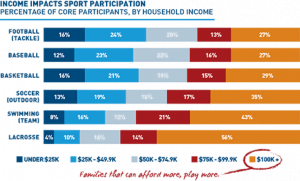 GRAPH A: Lee, A. 2015. 7 Charts that Show the State of Youth Sports in the US and Why it Matters. Aspen Institute. https://www.aspeninstitute.org/blog-posts/7-charts-that-show-the-state-of-youth-sports-in-the-us-and-why-it-matters/ Accessed 30th October 2017
GRAPH A: Lee, A. 2015. 7 Charts that Show the State of Youth Sports in the US and Why it Matters. Aspen Institute. https://www.aspeninstitute.org/blog-posts/7-charts-that-show-the-state-of-youth-sports-in-the-us-and-why-it-matters/ Accessed 30th October 2017
GRAPH B org, 2017. Study: Poverty and High Rates of TV Viewing Are Linked. https://www.movieguide.org/news-articles/study-poverty-and-high-rates-of-tv-viewing-are-linked.html Accessed 30th October 2017.
This apparent link may exist because of a positive multiplier effect, also known as cumulative causation. The graphic below shows how an active childhood can lead to a higher income in life and the passing of the benefits to the next generation, creating a virtuous spiral of improvement. However, there are multiple factors involved in such an effect and it is not appropriate to suggest that more physical activity is the only solution to societal problems.
Lee, A. 2015. 7 Charts that Show the State of Youth Sports in the US and Why it Matters. Aspen Institute. https://www.aspeninstitute.org/blog-posts/7-charts-that-show-the-state-of-youth-sports-in-the-us-and-why-it-matters/ Accessed 30th October 2017
There is one leisure activity which is on the rise in almost all LICs and MICs – watching TV.
GRAPH C :OFCOM, 2013. International Communications Market Report https://www.ofcom.org.uk/__data/assets/pdf_file/0027/38961/icmr_2013_final.pdf Accessed 30th October 2017
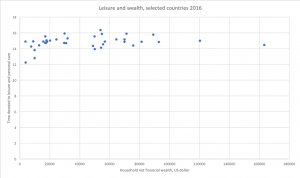
GRAPH D: OECD, 2016. http://stats.oecd.org/Index.aspx?DataSetCode=BLI# Accessed 30th October 2017
Similarly, the graph above shows the household wealth for selected countries against the time devoted to leisure (OECD, 2016).
However, the graph shows only the amount of leisure time, not the actual participation in specific leisure activities.
Even so, there are reasons why an increase in income might not lead to an increased participation in leisure activities:
- Higher income often means more food; this can lead to obesity making participation in sporting activities difficult
- In wealthier countries, transport and entrance fees can be very high which can put off people from participating in leisure activities
- The population is generally older in richer countries. An elderly population can be immobile and isolated by comparison to a more active youthful population that is generally found in low and middle income countries
C. Participation varies between countries: football example
The graphic below is from the 2014 World Football report (Repucom, 2014).

GRAPH E: Repucom, 2014. World Football. http://nielsensports.com/wp-content/uploads/2014/09/Repucom_World-Football.pdfAccessed 30th October 2017.
Graph F: Which countries work the longest hours (https://www.weforum.org/agenda/2015/07/which-countries-work-the-longest-hours/)
D. Section Review
- Suggest reasons why:
- A link might be expected between income and leisure participation. [3]
- There may be no link at all. [2]
- Explain why participation in leisure activities may vary due to income inequality within countries. [3]
- Do you think there is a link between income and leisure participation? Explain your reasons. [4]
Using the ideas from the positive multiplier effect on sports, add your own ideas into a flow diagram explaining the negative multiplier effect from a lack of participation. Give it an appropriate title such as ‘Negative cumulative causation from lack of participation in sports’. The number of steps is up to you but it should look something like this:
Sources
Lee, A. 2015. 7 Charts that Show the State of Youth Sports in the US and Why it Matters. Aspen Institute. https://www.aspeninstitute.org/blog-posts/7-charts-that-show-the-state-of-youth-sports-in-the-us-and-why-it-matters/ Accessed 30th October 2017
MovieGuide.org, 2017. Study: Poverty and High Rates of TV Viewing Are Linked. https://www.movieguide.org/news-articles/study-poverty-and-high-rates-of-tv-viewing-are-linked.html Accessed 30th October 2017.
OECD, 2016. http://stats.oecd.org/Index.aspx?DataSetCode=BLI# Accessed 30th October 2017
OFCOM, 2013. International Communications Market Report https://www.ofcom.org.uk/__data/assets/pdf_file/0027/38961/icmr_2013_final.pdf Accessed 30th October 2017
Repucom, 2014. World Football. http://nielsensports.com/wp-content/uploads/2014/09/Repucom_World-Football.pdf Accessed 30th October 2017.
Part 4 – Case Studies: China and the United States
By the end of this section you should be able to discuss two detailed examples illustrating recent changes in participation in leisure activities for both China and the United States.
A. Leisure patterns – China
- What do people in other countries do in their leisure time? Watch and comment: How Do Chinese People Hang Out
 Chongqing, China: Internet based gaming and other online activities are now more popular than physical sports in China.
Chongqing, China: Internet based gaming and other online activities are now more popular than physical sports in China.
In this section, we look at the recent growth in the income and leisure time for people in China, and assess the impact this has had on participation in sport and tourism in the world’s most populous country.
Answer these questions as notes about leisure patterns in CHINA
- Describe THREE characteristic LEISURE activities in your country and THREE SPORT activities.
- Explain THREE the reasons why leisure activity patterns have changed in the country. Support your explanations with some examples (facts and figures).
- Explain the country’s SUCCESS in Give THREE reasons.
- Explain THREE the reasons why sporting activity patterns have changed in the country. Support your explanations with some examples (facts and figures).
- Suggest why tourism is increasing in China. (3 reasons)
- Use the sources to identify the range of countries that people travel to from China. Suggest why these countries are the most popular.
I. Introducing leisure in China
Watch a few minutes of each clip (excluding the last one!)
China is experiencing an increase in leisure time and participation in sport and tourism. This is partly the result of a growing economy, which gives individuals and the government more disposable income to spend on sports and tourism. The income per capita is shown in the graph below (Gapminder, 2017).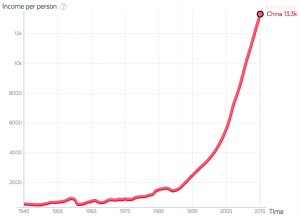 Source: Gapminder, 2017. Income Per Person in China 1945-2015. http://www.gapminder.org/tools
Source: Gapminder, 2017. Income Per Person in China 1945-2015. http://www.gapminder.org/tools
At the same time as increasing income, Chinese people are also having more leisure time than before. In 1995, the two-day weekend was introduced for many people and in 1999 the Chinese government introduced a policy of giving all workers three weeks off per year at set times (May Day, Spring Festival and National Day). This policy was updated in 2008 to give two full-week holidays and five three-day holidays per year (Tu, 2010).
This resulted in the so-called “Golden Week”, such as around National Day on 1st October, with virtually the entire country taking the week off and many of China’s migrant workers returning to their family homes in the central and western provinces. There are problems associated with this growth, including transport chaos and very high prices for hotels and travel. However, destinations such as Hong Kong experience an increase in tourism and commercial activity as Chinese people spend their hard earned money.
What do Chinese people do with all this free time? The most popular activity is to travel to nearby destinations, followed by spending time on the internet, and finally go to the movies. 39% of Chinese people report movie-going as a favorite pastime, with a very fast rate of growth for cinema tickets of 40% from 2015 to 2016 (Daxue Consulting, 2016).
II. Sports
China has been gaining ground in its sporting achievements as shown by summer Olympic medals won, in the graph below (Laurent, 2017).
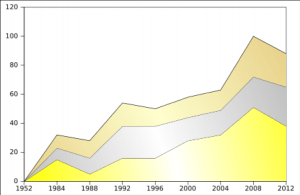
Source: Laurent, J, 2017. Own work, CC BY-SA 3.0, https://commons.wikimedia.org/w/index.php?curid=20652617 Accessed 1st November 2017.
Watch: Look inside China’s secretive Olympic training camps | The Economist (7:09 min)
Despite a strong focus on national pride in elite sporting competitions, historically China has not been considered a sporting nation. This has begun to change; recent growth is not just amongst elite athletes. For example, visits to ski regions were 5.5 million in 2009, but by 2016 had reached 15.1 million, and Beijing is the host of the 2022 Winter Olympics which is anticipated to be a major spectator event (Klingelhöfer, 2017). Similar growth is happening in many sporting sectors, such as football. The infographics below shows the variety of sports that interest people in China (State Council, 2015).
Source: State Council [of the People’s Republic of China], 2015. Sports participation soars in China http://english.gov.cn/policies/infographics/2015/12/31/content_281475263806063.htm Accessed 1st November 2017.
This is partly the result of the government’s policy on fitness. After the Beijing summer Olympics in 2008, the State Council made ‘Sports for All Day’ annually on 8th August. In 2016 it was announced the National Fitness Plan to 2020 would follow from the 12th National Plan for 2011-2015, which resulted in an increase in medium intensity exercise participation from 28.2% of the population in 2007 to 33.9% by 2014 (Xiaochen, 2015).
The 2016-2020 Five Year Plan includes 1.8 square meters per person to be allocated for sports within 15 minutes of people’s homes (Liddle, 2016). The government also invested in sports directly in 2015 by providing around US$130 million to over 1200 sports venues to reduce or eliminate fees (Xiaochen, 2015). The Ministry of Education also planned in 2015 to encourage the growth of football by identifying 20000 schools for promotional activities, rising to 50,000 by 2025 (Xua, Gaob, and Zhao, 2016).
This increase in participation is worth money to the country. The value of sports is aimed to be around US$772 billion by 2025. This is around 1% of GDP compared to 0.63% in 2013 (Xiaochen, 2015).
III. Tourism
Chinese tourism has similarly grown. The table below shows the spending in US dollars on international tourism by citizens of selected countries, showing China has increased consistently and is now the top spender in the world (Jian-jun and Nas, 2014).
Watch: London and Paris fight for Chinese tourism money
(3:00 min)
Source: Jian-jun, M. and Nas, R.F., 2014. Profile of Chinese Outbound Tourists: Characteristics and Expenditures. American Journal of Tourism Management, 3(1), pp.17-31. http://article.sapub.org/10.5923.j.tourism.20140301.03.html#Sec2.1 Accessed 1st November 2017.
It is not just that Chinese people are becoming wealthier and spending more; the number of people traveling abroad is also increasing, as shown in the table below (Jian-jun and Nas, 2014).
Source: Jian-jun, M. and Nas, R.F., 2014. Profile of Chinese Outbound Tourists: Characteristics and Expenditures. American Journal of Tourism Management, 3(1), pp.17-31. http://article.sapub.org/10.5923.j.tourism.20140301.03.html#Sec2.1 Accessed 1st November 2017.
The graph below shows more up-to-date figures (World Travel Online, 2017). (The % figure is the increase on the previous year.)
Source: World Online Travel, 2017. Chinese Outbound Tourism Statistics in 2016: 122 Million Chinese Tourists Make Outbound Trips, Spend $109.8 Billion. http://news.travel168.net/20170203/43145.html Accessed 1st November 2017.
Watch: Finland prepares for Chinese tourism in Northern Europe (8 min)
However, this is only part of the story. In all of these years, over half of the visits ended in Greater China – including Hong Kong and Macau which have their own immigration status under the ‘One Country, Two Systems’ approach, with the rest of the country being termed ‘Mainland China’. In 2016, for the first time, 51.2% of all trips by mainlanders went outside of Greater China (Arlt, 2017). All regions registered an increasing in tourism, but the greater numbers heading to Europe and North America rather than Asia suggests that people are more adventurous and, through media coverage, are more aware of less traditional destinations. Iceland, Poland and Georgia increased by more than 40% while Nepal increased by 56%.
Watch: Do Chinese tourists deserve their ‘rude’ reputation? – BBC Trending (3 min)
Chinese police on patrol in Italy to boost tourism
As you watch: “ How to be a Chinese Tourist – 101 East “, consider:
- How mass tourism from China has changed areas of Paris
- Give at least 3 actual examples from the clip – think of positive and negative impacts
- Two management strategies used by Parisians and Chinese tour guides to help reduce some of the negative impacts
- Discuss two ways Chinese tourism is changing Paris.
Check In – Leisure patterns in China
Questions:
- Describe the changes taking place in the leisure preferences of people in China. [3]
- Suggest why sports are being taken up in record numbers. [4]
- Suggest why tourism is increasing. [4]
- Use the sources to identify the range of countries that people travel to from China. Suggest why these countries are the most popular. [4]
B. Leisure patterns – United States of America
As we work through the readings below, you will have to answer the following questions on this country as notes in your notes.
- Describe THREE characteristic LEISURE activities in this country and THREE SPORTING
- Explain THREE the reasons why leisure activity patterns have changed /not changed in the country. Support your explanations with some examples (facts and figures).
- Explain the country’s SUCCESS in SPORT activities. Give THREE reasons.
- Explain THREE the reasons why sporting activity patterns have changed in the country. Support your explanations with some examples (facts and figures).
- Outline the extent of tourism in the USA.
- Justify the pattern of tourism observed in the USA.
- Describe the amount of expenditure on tourism by Americans and explain why tourist expenditure is increasing at a faster rate than participation in tourist trips.
I. Introducing leisure in the USA
The USA is the world’s largest economy and has a population of over 320 million. The income per capita has increased fairly consistently for several decades as shown on the graph below (Gapminder, 2017).
Gapminder, 2017. Income Per Person in USA 1945-2015. http://www.gapminder.org/tools
People in the USA report high levels of engagement in leisure activities and sports. The graph below shows the average percentage of U.S. population engaged in sports and leisure activities per day from 2010 to 2016 (Statista, 2017). Though the graph appears to fluctuate a lot, overall rates are consistently above 95%.
Statista, 2017. Average percentage of U.S. population engaged in sports and leisure activities per day from 2010 to 2016. https://www.statista.com/statistics/189548/daily-engagement-of-the-us-population-in-leisure-and-sports/ Accessed 1st November 2017.
- What do people in the USA do in their leisure time? Watch: Top 10 Best Things Americans Do In Their Free Time
In the United States, there is a gender gap, with men reporting more engagement in leisure and sports. Although men spend around ten hours more per week in formal work, women spend around more hours than men doing housework, plus looking after children. This supports the ‘woman as homemaker’ paradigm whereby even if women are working, they are more likely to take on responsibilities for housework such as childcare, cleaning and cooking. The result is that American women spend around five hours less per week on leisure activities (Pew Research Centre, 2013).
II. Sports
Why is the USA so successful in sports?
Read the Article and decide which are the most important 3 reasons (add to your notes).
Why is USA so successful in so many sports?
Participation in physical exercise and sports has remained largely consistent in the USA over recent years. The graph below shows how the level of inactivity (shown in red at the bottom of the scale) has not changed (Physical Activity Council, 2017).
Physical Activity Council, 2017. 2017 Participation Report. http://www.physicalactivitycouncil.com/pdfs/current.pdf Accessed 1st November 2017.
One reason for this may be that although income has gone up in the USA overall, there is still an inequality in the distribution of that wealth. The graph below shows the inactivity levels – i.e. the percentage of people who are NOT exercising (Physical Activity Council, 2017). The wealthier the person, the more likely they are to exercise. However, any increase in activity levels of wealthy people is balanced by a reduction in the activity of those on lower incomes.
Physical Activity Council, 2017. 2017 Participation Report. http://www.physicalactivitycouncil.com/pdfs/current.pdf Accessed 1st November 2017.
A recent phenomena that may be affecting the figures is that of fitness trackers. Despite the expense of the technology, around 12% of people were using fitness trackers in the USA in 2016. The graph below shows that there is an increase in the number of people using fitness tracking actively (i.e. to help them train), suggesting a possible link between wealth and fitness.
Physical Activity Council, 2017. 2017 Participation Report. http://www.physicalactivitycouncil.com/pdfs/current.pdf Accessed 1st November 2017.
III. Tourism
Tourism by people from the United States is dominated by domestic tourism. While there has been some recent growth in tourism – and this has been led by international tourism – the figures have remained largely constant. It’s a myth that only 14% of Americans have passports – the number in circulation in 2016 was 131,841,062, according to the US Department of Passports and International Travel (USDPIT, 2017) for a population of around 320 million. What is the %?
A possible reason for the lack of increase in tourism is the number of days vacation per year. One in four Americans has no paid vacation time at all, while the average is just sixteen days per year (Hess, 2013). This is much lower than in other countries such as in the European Union where every worker is guaranteed no less than four weeks off per year.
A further reason is that it is time-consuming and expensive to travel the long distances required for most Americans to travel out of their country. Whereas in Europe, many people would need to travel for less than a few hours to reach several other countries, the continental scale of the United States makes this proposition harder. Also, there isn’t much need to travel beyond the national border to experience a huge diversity of landscapes and environments.
However, the table below (US Travel Association, 2016) shows that although tourist numbers have only slightly increased, the spending on tourist activities has gone up significantly – by over US$200 billion. This can be explained by the desire of Americans to spend more on the limited free time that they have for tourist activities.
US Travel Association, 2016. Travel Volume To And Within The United States. https://www.ustravel.org/system/files/media_root/document/Research_Fact-Sheet_US-Travel-and-Tourism-Overview.pdf Accessed 1st November 2017
IV. Extension
- Read through the article “Changing Times
How Americans spend their day reflects a shifting economy and population
Note down the causes of some differences (ie why) in how American spend their leisure time.
2.Look at the participation in sports. Create a publicity poster to encourage a specific demographic (sex, age, income) to participate more in sports.
Adapted from: https://geographycasestudysite.wordpress.com/usa-sports-and-tourism/
Sources
Arlt, W. G., 2017. Chinese Tourists Look For New Destinations In 2016 https://www.forbes.com/sites/profdrwolfganggarlt/2017/02/07/chinese-tourists-look-for-new-destinations-in-2016past-the-mainland-in-2016/#11d8c1fa5b3a Accessed 1st November 2017.
Daxue Consulting, 2016. Chinese Leisure Activities: Three New Market trends http://daxueconsulting.com/chinese-leisure-activities/ Accessed 3rd November 2017.
Gapminder, 2017. Income Per Person in China 1945-2015. http://www.gapminder.org/tools
Jian-jun, M. and Nas, R.F., 2014. Profile of Chinese Outbound Tourists: Characteristics and Expenditures. American Journal of Tourism Management, 3(1), pp.17-31. http://article.sapub.org/10.5923.j.tourism.20140301.03.html#Sec2.1 Accessed 1st November 2017.
Klingelhöfer, C. 2017. These are the Most Popular Sports in China. https://www.ispo.com/en/markets/id_79708806/these-are-the-most-popular-sports-in-china.html Accessed 1st November 2017.
Laurent, J, 2017. Own work, CC BY-SA 3.0, https://commons.wikimedia.org/w/index.php?curid=20652617 Accessed 1st November 2017.
Liddle, J. 2016. China’s New National Fitness Plan and Opportunities in the Sports Industry. http://www.china-briefing.com/news/2016/09/01/china-new-national-fitness-plan-opportunities-sports-fitness-industry.html Accessed 1st November 2017.
State Council [of the People’s Republic of China], 2015. Sports participation soars in China http://english.gov.cn/policies/infographics/2015/12/31/content_281475263806063.htm Accessed 1st November 2017.
Tu, Y. 2010. Chinese Leisure Life: the two-day weekend revolution. http://confuciusmag.com/chinese-leisure-life Accessed 3rd November 2017.
World Online Travel, 2017. Chinese Outbound Tourism Statistics in 2016: 122 Million Chinese Tourists Make Outbound Trips, Spend $109.8 Billion. http://news.travel168.net/20170203/43145.html Accessed 1st November 2017.
Xiaochen, S. 2015. Chinese embrace exercise as lifestyle choice. http://usa.chinadaily.com.cn/epaper/2015-12/31/content_22885583.htm Accessed 1st November 2017.
Xu, Gao, Zhao, 2016. National football promotion in China: Opportunities and challenges in public health[J]. Journal of Sport and Health Science, 2016, 5(2): 250-251. http://www.jshs.org.cn/EN/abstract/abstract359.shtml Accessed 1st November 2017.
Gapminder, 2017. Income Per Person in USA 1945-2015. http://www.gapminder.org/tools
Hess, A., 2013. On holiday: Countries with the most vacation days https://www.usatoday.com/story/money/business/2013/06/08/countries-most-vacation-days/2400193/ Accessed 1st November 2017.
Physical Activity Council, 2017. 2017 Participation Report. http://www.physicalactivitycouncil.com/pdfs/current.pdf Accessed 1st November 2017.
Pew Research Centre, 2013. Another Gender Gap: Men Spend More Time in Leisure Activities. http://www.pewresearch.org/fact-tank/2013/06/10/another-gender-gap-men-spend-more-time-in-leisure-activities/ Accessed 1st November 2017.
Statista, 2017. Average percentage of U.S. population engaged in sports and leisure activities per day from 2010 to 2016. https://www.statista.com/statistics/189548/daily-engagement-of-the-us-population-in-leisure-and-sports/ Accessed 1st November 2017.
Topline, 2017. Outdoor Recreation Participation Topline Report 2017 https://outdoorindustry.org/wp-content/uploads/2017/04/2017-Topline-Report_FINAL.pdf Accessed 1st November 2017.
USDPIT [US Department of Passports and International Travel], 2017. Valid Passports in Circulation (1989-2016). https://travel.state.gov/content/passports/en/passports/statistics.html Accessed 1st November 2017.
US Travel Association, 2016. Travel Volume To And Within The United States. https://www.ustravel.org/system/files/media_root/document/Research_Fact-Sheet_US-Travel-and-Tourism-Overview.pdf Accessed 1st November 2017

